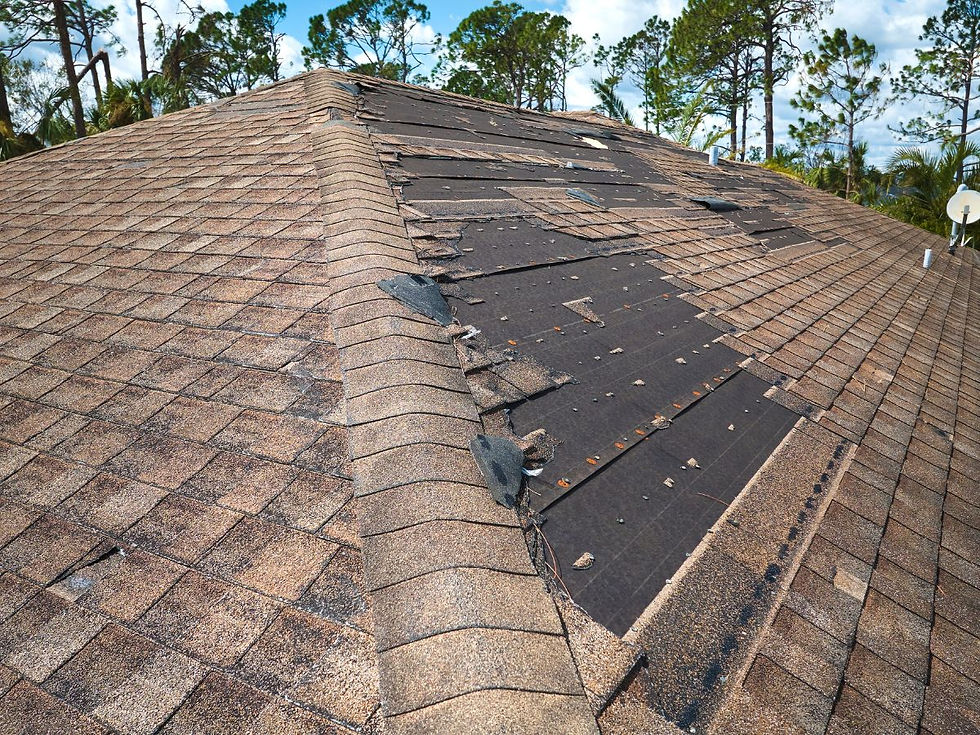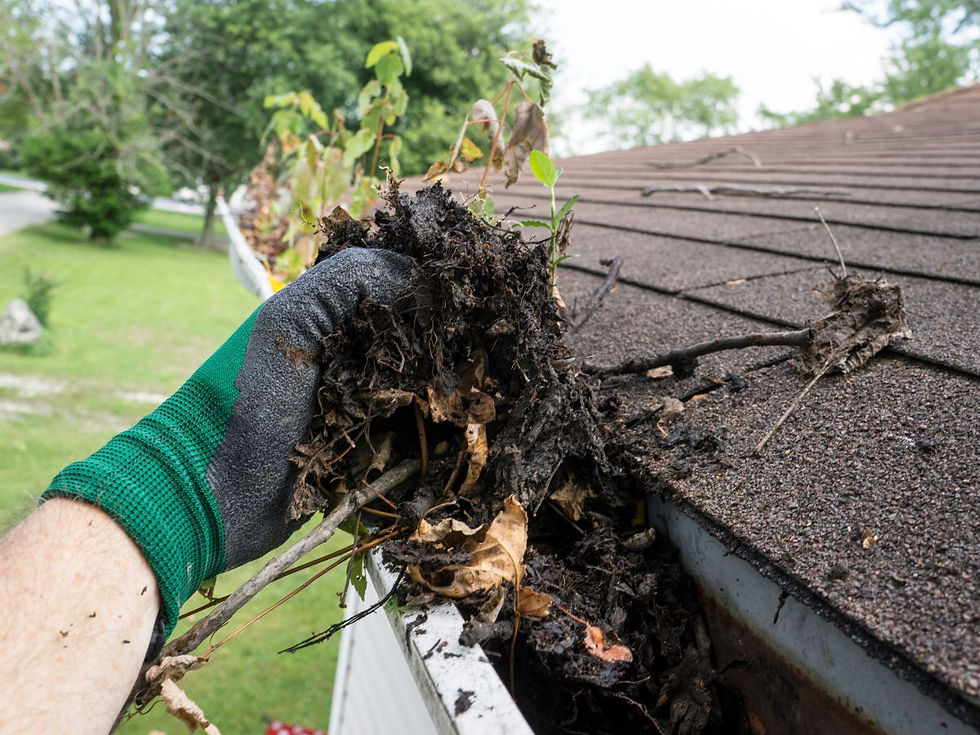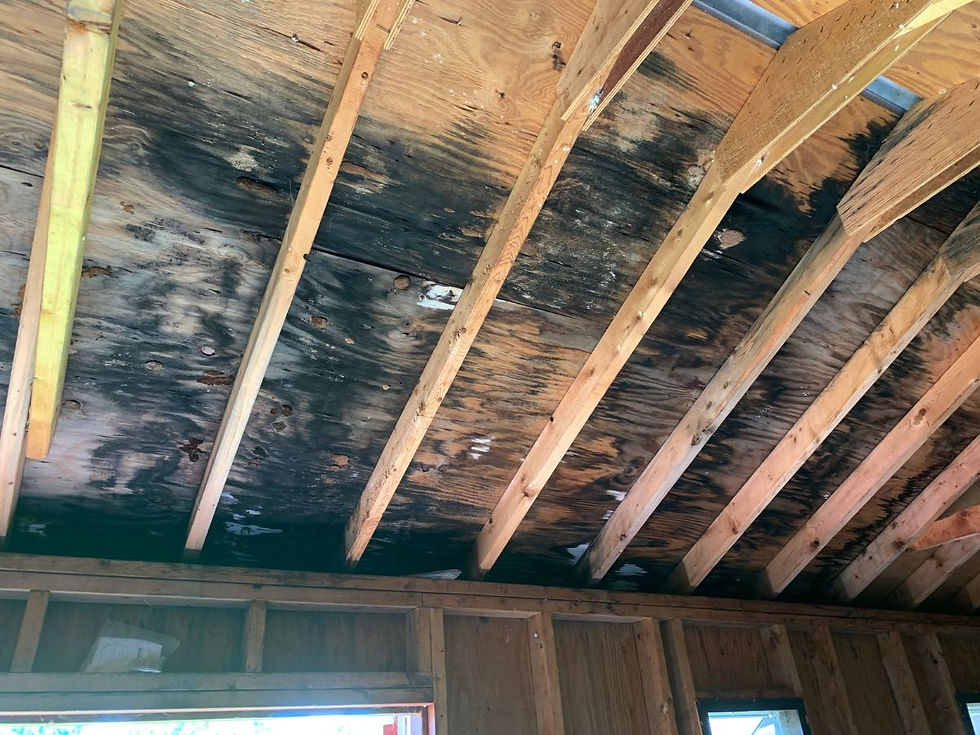10 Signs Your Roof Needs Repair Before Winter
- elevatedroofingsol
- Nov 4, 2024
- 10 min read
As winter approaches, ensuring your roof is in top condition is vital. Key signs that repairs may be necessary include missing or damaged shingles, granules in gutters, and visible sunlight through the roof. Water stains on ceilings and increased energy bills may signal underlying issues, while mold, moss growth, or flashing damage indicate moisture problems. A sagging roof deck, attic leaks, and if it’s been decades since installation, are also red flags. Addressing these concerns early can prevent winter damage and costly repairs. For a detailed understanding of these warning signs, there’s more to discover.
Key Takeaways
Missing or damaged shingles indicate the need for immediate roof repairs.
Granules in gutters suggest shingle deterioration requiring attention.
Water stains on ceilings signal possible roof leaks needing urgent repair.
Visible sunlight through the roof highlights gaps or holes compromising integrity.
A sagging roof deck indicates potential structural integrity issues needing inspection.
1. Missing or Damaged Shingles

When it comes to maintaining the integrity of your roof, missing or damaged shingles are a clear indicator that repairs are necessary. Shingles play a crucial role in protecting your home from the elements, so understanding their lifespan and when replacement is needed is essential. The average shingle lifespan varies depending on material quality and environmental conditions but typically ranges from 20 to 30 years. Regular inspections can help identify issues early, allowing for timely intervention before extensive damage occurs.
Repair techniques for shingles can vary. For minor issues, such as a single missing shingle, a simple replacement might suffice. However, if the damage is widespread, a more comprehensive approach may be needed. This could involve replacing entire sections of the roof to ensure uniform protection. Moreover, considering the weather impact is crucial, as extreme conditions like hail, wind, or heavy rain can accelerate shingle deterioration and compromise the roof’s overall performance.
The effects of damaged shingles extend beyond the surface. One significant consequence is the reduction in insulation effectiveness. Missing or damaged shingles can lead to increased energy costs as heat escapes more easily, prompting your HVAC system to work harder. Therefore, timely repair not only maintains your roof but also enhances your home’s energy efficiency. When faced with the necessity for shingle replacement, exploring various replacement options is advisable. Options may include asphalt, wood, metal, or composite shingles, each offering distinct benefits and aesthetics.
Selecting suitable materials and repair techniques is key to prolonging the lifespan of your roof while safeguarding your home.
2. Sagging Roof Deck

Addressing the integrity of your roof extends beyond shingle maintenance; a sagging roof deck is another critical issue that requires attention. A sagging roof deck often indicates underlying problems that could compromise the structural integrity of the entire roofing system.
It typically results from the deterioration of roof deck materials due to prolonged exposure to moisture, poor ventilation, or both. Moisture retention can weaken the materials, leading to a loss of structural support and insulation issues that can escalate into more severe problems if neglected. One of the primary causes of a sagging roof deck is the accumulation of water due to inadequate drainage or leaks. Moisture can lead to the warping or rotting of wood-based materials, which are commonly used in roof decks.
This degradation not only affects structural integrity but can also impact the effectiveness of your home’s insulation, leading to increased energy costs as your heating system works harder to maintain a stable indoor temperature. Repairing a sagging roof deck can be costly, depending on the extent of the damage and the materials required. Early detection is crucial; therefore, regular inspections by roofing professionals are recommended.
They can identify symptoms such as visible dips or uneven areas in the roofline, which are indicative of sagging. Addressing these issues promptly can mitigate repair costs by preventing further deterioration.
3. Water Stains on Ceilings

Water stains on ceilings are among the most noticeable indicators that your roof may need repair. These unsightly marks not only affect the aesthetic appeal of your home but also signal potential underlying issues that require immediate attention. Water damage is often the primary culprit behind such stains, indicating that moisture has permeated your roof’s defenses, leading to interior leaks. When left unchecked, this can result in more severe structural damage and costly repairs.
Moisture buildup within your home can stem from various sources, but a compromised roof is a frequent offender. Roof leaks can occur due to damaged or missing shingles, improperly sealed roof valleys, or deteriorating flashing. Once moisture finds its way into your home, it can seep into insulation materials, reducing their effectiveness and further exacerbating the problem. Insulation issues can lead to increased energy bills and uncomfortable indoor environments, especially as winter approaches.
Ceiling repairs become necessary once water stains appear, as they can lead to mold growth and weaken the ceiling’s integrity over time. Addressing the root cause, however, is crucial to preventing future occurrences. A thorough inspection of your roof should be conducted to identify and rectify any vulnerabilities. This may involve repairing damaged shingles, resealing areas prone to leaks, or improving ventilation to minimize moisture accumulation.
4. Granules in Gutters

In addition to visible water stains on ceilings, another indicator that your roof may require attention is the presence of granules in your gutters. Granules, which are small, sand-like particles, play a crucial role in protecting asphalt shingles from the sun’s ultraviolet rays and harsh weather conditions. Over time, granule accumulation in gutters can signify that your shingles are deteriorating, which can be a precursor to more significant roofing issues.
One of the primary reasons for granule loss is the natural aging process of roofing materials. As shingles age, they become more susceptible to the impact of weather, such as heavy rains, wind, and temperature fluctuations, which can cause granules to dislodge.
Frequent gutter maintenance is essential to monitor and manage granule accumulation, as it provides a clear view of the extent of shingle wear and tear. Regularly checking your gutters for granules also aids in preventing clogs, which can lead to water overflow and further damage to your home’s exterior.
The roof lifespan is significantly affected by the rate at which granules are lost. A rapid increase in granule accumulation suggests that the roof is nearing the end of its functional life, prompting repair urgency.
Addressing granule loss sooner rather than later can prevent extensive damage and costly repairs in the future. Homeowners should consider consulting a professional roofing contractor to assess the condition of their shingles and determine the appropriate course of action to extend the life of their roof before severe weather sets in.
5. Flashing Damage

A critical aspect of roof maintenance is monitoring the condition of the flashing, which serves as a protective barrier against water intrusion at intersections and joints on the roof. Flashing is essential in areas where roofing materials meet chimneys, vents, and skylights. Various flashing types, such as step flashing, counter flashing, and continuous flashing, are designed to address specific roofing configurations and challenges.
Flashing materials typically consist of metals like aluminum, copper, or galvanized steel, chosen for their durability and resistance to the elements. However, even the most robust materials are not immune to damage over time. Factors such as weather conditions, improper flashing installation, or lack of flashing maintenance can lead to deterioration. This damage might manifest as cracks, warping, or even complete detachment, compromising the roof’s integrity.
Regular flashing inspections are vital to detect early signs of damage before they escalate into more significant issues. During these inspections, look for visible signs of wear, such as rust or missing sections, and pay close attention to any bending or separation from the roof. Additionally, ensure that flashing installation was done correctly, with no gaps or loose edges that could allow water penetration.
Taking proactive steps in flashing maintenance can prevent costly repairs and extend the lifespan of your roof. This might include resealing joints, replacing damaged flashing, or even upgrading to more durable flashing materials if necessary.
6. Leaks in the Attic

Identifying leaks in the attic is crucial for maintaining the structural integrity of your home. Leaks can lead to a cascade of problems that not only affect the roof but also the overall safety and comfort of the living space beneath. One of the first signs of a leak is moisture buildup, which can manifest as damp patches or water stains on attic surfaces.
Moisture compromises attic insulation, reducing its effectiveness and potentially leading to increased heating costs during the winter months.
Proper attic ventilation is vital in preventing these issues. Ventilation allows moist air to escape, reducing the chances of condensation that can aggravate leak-related problems. Insufficient ventilation might exacerbate insulation issues, as trapped moisture can lead to compromised insulation materials, further affecting energy efficiency.
Another concern linked with attic leaks is pest infestations. Damp and warm environments are attractive to pests, which may find their way into your home through compromised roofing. These unwanted guests not only pose health risks but can also cause additional structural damage.
Effective roof maintenance is key to preempting attic leaks. Regular inspections can help identify potential problem areas before they develop into significant issues.
Addressing minor repairs promptly, such as replacing damaged shingles or sealing small gaps, can prevent leaks from occurring in the first place.
7. Mold or Moss Growth

Addressing leaks in the attic is not the only concern when it comes to maintaining a healthy roof; mold or moss growth presents another significant issue that requires attention. Mold and moss thrive in environments where moisture management is lacking, often leading to compromised structural integrity and decreased longevity of roofing materials. To effectively combat these growths, it is crucial to implement mold prevention strategies and conduct regular seasonal inspections.
Proper roof ventilation plays a vital role in these efforts, as it helps to regulate temperature and moisture levels, reducing the likelihood of mold proliferation. Additionally, moss removal should be conducted promptly to prevent the moisture-retaining plant from damaging shingles and facilitating further growth. It’s essential to recognize that mold and moss not only affect the roof’s aesthetic appeal but can also lead to costly repairs if left unchecked.
Here’s a concise overview of key actions for dealing with mold and moss growth:
Key Action | Purpose | Result |
Mold Prevention | Reduce moisture accumulation | Protect roof integrity |
Moss Removal | Eliminate moisture retention | Prevent shingle damage |
Roof Ventilation | Control temperature/moisture | Inhibit mold/moss growth |
Employing these strategies ensures that the roof remains in optimal condition, enhancing its ability to withstand the rigors of winter weather. Regular maintenance, including moisture management and seasonal inspections, goes a long way in preserving the roof’s functionality and appearance. When addressing mold or moss growth, it is advisable to consult with roofing professionals to ensure comprehensive and effective treatment, safeguarding the roof against future issues.
8. Increased Energy Bills

Rising energy bills can serve as a subtle indicator of underlying roof issues that necessitate attention. As winter approaches, ensuring your home is energy efficient becomes increasingly crucial. A compromised roof can significantly affect energy efficiency, driving up heating costs. Several components of the roof contribute to this issue, including insulation quality, roof ventilation, and the overall integrity of the roofing materials.
Poor insulation quality is often a primary culprit when it comes to increased energy bills. When insulation is insufficient or deteriorated, the heat generated inside your home escapes more easily, forcing your heating system to work overtime to maintain comfortable temperatures. This inefficiency not only disrupts your winter preparedness but also results in substantial cost savings being lost in the form of higher energy bills.
Roof ventilation is another critical factor influencing energy efficiency. Proper ventilation allows for the circulation of air, preventing the buildup of moisture and maintaining a balanced temperature within your attic space. Inadequate ventilation can lead to heat being trapped, which can cause your heating system to expend more energy, further escalating energy costs during the colder months.
Addressing these issues before winter sets in can lead to significant cost savings. By enhancing insulation quality and ensuring effective roof ventilation, homeowners can improve their energy efficiency and maintain a comfortable indoor environment without the burden of excessive energy expenses.
Regular inspections and timely repairs not only enhance winter preparedness but also extend the lifespan of your roof, offering long-term financial benefits.
9. Visible Sunlight Through Roof

A sudden increase in energy bills often signals potential roof issues, but another unmistakable sign of roof damage is the presence of visible sunlight through the roof. When sunlight permeates your attic or any other part of your home through the roof, it is a clear indication that gaps or holes have compromised the roof’s structural integrity.
These openings not only allow sunlight to enter but also pose a risk for water infiltration, which could lead to significant sunlight damage and threaten the durability of your roof.
Conducting a thorough roof inspection is crucial to accurately assess the condition of your roof. During the inspection, look for any visible cracks, missing shingles, or spaces around flashing and skylights.
Such vulnerabilities can compromise moisture barriers, allowing not only light but also water to penetrate, which can exacerbate existing issues and lead to costly repairs if left unattended. Addressing these problems promptly as part of your seasonal maintenance routine is vital to safeguard your home against the harsh winter elements.
The presence of sunlight through the roof, while seemingly minor, should not be underestimated. It signals potential weaknesses that could escalate into severe structural problems over time.
An effective response involves timely intervention, such as patching holes, replacing damaged shingles, and reinforcing moisture barriers. By maintaining the structural integrity of your roof through regular inspections and timely repairs, you ensure that your home remains protected year-round.
Prioritizing these measures will not only enhance your home’s energy efficiency but also extend the life of your roofing system.
10. Age of the Roof

The age of the roof is a crucial factor in determining its current condition and potential need for repair. As roofs age, their susceptibility to damage increases, making regular seasonal inspections essential. Understanding the expected roof lifespan can help homeowners foresee potential issues and plan accordingly. Different roof materials have varying lifespans; for instance, asphalt shingles typically last 20 to 30 years, while metal roofs can endure for up to 50 years or more.
Roof Material | Expected Lifespan (Years) |
Asphalt Shingles | 20-30 |
Metal Roofs | 40-70 |
Tile Roofs | 50-100 |
Regular maintenance and timely repairs can extend a roof’s lifespan, potentially saving significant repair costs. Homeowners should bear the responsibility of monitoring their roof’s condition and scheduling inspections. These inspections are particularly vital before winter, as colder temperatures and harsh weather conditions can exacerbate existing issues.
Furthermore, understanding the age of the roof can aid in budgeting for future expenses. As roofs near the end of their lifespan, the frequency and cost of repairs tend to increase. Proactive measures, such as replacing worn materials and addressing minor damages promptly, can help mitigate long-term expenses.
Final Thoughts
As winter approaches, it’s vital to ensure your roof is in top condition to avoid costly repairs and maintain comfort throughout the colder months. If you notice any of the 10 signs mentioned—such as missing or damaged shingles, granules in gutters, or visible sunlight through the roof—now is the time to act. At Elevated Roofing Solutions, we are committed to delivering quality roofing services with a focus on customer satisfaction. Schedule your free inspection today and let us ensure your roof is winter-ready!

Comments